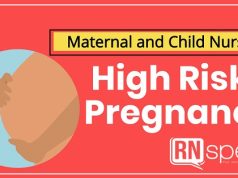Case: Ana, a 40-year-old female came into the Emergency Room complaining of vaginal bleeding. She has been known to be pregnant for 5 weeks. The doctor assessed her noting for her last menstrual period and indicated an internal examination.
A complete abortion was the diagnosis of the doctor. Ana and her husband grieve for the loss of their first baby. No previous medications or plans for abortion were gathered.
This is an example of spontaneous abortion. Sometimes called a miscarriage, it is further defined as pregnancies that did not reach the 20th week of gestation. There are different cases of spontaneous abortion:
- Complete abortion – products of conception were expelled from the body completely. It is important to note that the term “products of conception” is used to describe the blood vessels, sac, and initial parts of the fetus.
- Incomplete abortion – some products of conception remained in the body. Completion curettage may also be indicated in order to remove the tissues from the uterus. If left untreated, this may be a source of generalized infection.
- Missed abortion – the pregnancy could not proceed to its succeeding weeks and the products of conception must be taken out from the body through surgical intervention.
- Infected or septic abortion – products of conception were expelled however, the vaginal lining and the reproductive system of the woman was infected.
- Inevitable abortion – for some factors, the pregnancy is lost and symptoms could not be intervened. Antiphospholipid syndrome (APAS) was one of the reasons why women may suffer from inevitable abortion.
Predisposing factors:
- Chromosomal deficiencies of the fetus
- Vices (Drugs and alcohol)
- Previous infection
- Obesity
- Other gynecological problems
- Hormonal imbalances
- Smoking
- Diabetes
Risk factors:
- Previous miscarriages
- High-risk pregnancy (age of the mother is more than 35 years old)
Symptoms:
- Vaginal bleeding with pain or without pain
- Lower back pain or abdominal pain described to be dull or sharp
Diagnostic Tests
In order to know if the products of conception have been completely expelled or not, certain examinations must be done.
- Pelvic examination – The patient will be taken into the examination bed in a Lithotomy position. The cervix will be checked if it is open or not.
- Abdominal ultrasound or vaginal ultrasound – Ultrasonography is important in order to help determine the internal condition of the uterus, the development of the fetus as well as bleeding tendencies.
- Blood studies:
A. Rh typing – Those women who have Rh-negative blood types may need immune globulin therapy. Rh incompatibilities can also be the reason for inevitable abortions.
B. Complete blood count – The amount of haemoglobin and haematocrit must be noted in order to note the blood loss. Infection can also be noted when the white blood cells are elevated.
C. Human chorionic gonadotropin – This helps in confirming the pregnancy or if it is an H-mole.
Treatment:
- Dilatation and Curettage – This is indicated when the products of conception did not completely exit the body. Surgical removal of the tissues and blood clots can prevent infection.
- Misoprostol therapy – This plan uses pharmacological intervention so that the remaining tissues can be expelled.
Case discussion:
On Ana’s case, she is actually on the high-risk bracket making pregnancies to be more likely to lead to However, this does not hamper them to attempt another pregnancy. It is better to have a comprehensive prenatal check-up so that the baby can be monitored closely.








